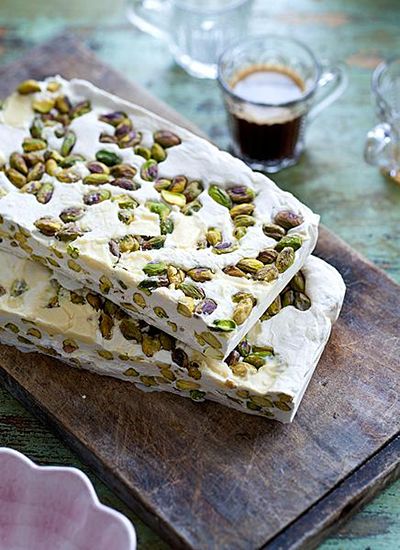
What is Gaz of Isfahan ?
What is Gaz of Isfahan ?
- Adam Smith
- 10-04-2025
- 23-07-2025
- 1648 views
- coffeepedia

When it comes to unique and culturally rich sweets, few can rival the elegance and heritage of Gaz of Isfahan. Known as the “Persian Nougat,” Gaz is a traditional Iranian confection that has stood the test of time for over four centuries. Loved for its chewy texture, delicate sweetness, and rich history, Gaz continues to be a treasured symbol of Persian hospitality and culinary artistry. In this blog, we explore the origins, ingredients, cultural significance, and reasons why Gaz remains a beloved treat around the world.
A Sweet Origin Rooted in Nature
The word “Gaz” is derived from the Gaz-angubin plant (Tamarisk tree), a shrub native to the Zagros Mountains of Iran. Gaz-angubin translates to “sap of tamarisk,” and it’s this sweet, natural exudate that originally gave Gaz its distinctive flavor. Traditional Gaz was made using this sap, which was harvested during a short window each year when small insects feed on the tamarisk tree, leaving behind the sweet substance. Although modern Gaz recipes often use sugar or corn syrup instead of gaz-angubin, some artisans in Isfahan still preserve this ancient method.
Ingredients That Tell a Story
Traditional Gaz typically includes:
- Sugar or corn syrup (or Gaz-angubin in traditional recipes)
- Egg whites (for aeration and a fluffy, nougat-like texture)
- Pistachios or almonds (crunchy, earthy notes)
- Rosewater or cardamom (for that aromatic Persian signature)
The result is a soft, chewy nougat that’s subtly sweet, aromatic, and slightly nutty. Some variations include saffron or dried fruits for an even more luxurious experience.
Cultural Significance in Persian Life
In Iran, Gaz is more than just a sweet treat—it’s a cultural emblem. It’s commonly served with tea when guests arrive and is a must-have during Nowruz (Persian New Year) celebrations. Offering Gaz to guests is a gesture of warmth and generosity.
It is also a popular souvenir, especially from the city of Isfahan, where skilled confectioners take pride in crafting high-quality Gaz using age-old techniques passed down through generations. The packaging is often ornate, reflecting the elegance of Persian art.
How Gaz is Made: An Art and a Science
Making Gaz is a labor-intensive process that requires precision and patience:
- Egg whites are beaten until frothy.
- A sugar or gaz-angubin syrup is cooked until it reaches the right consistency.
- The hot syrup is slowly folded into the egg whites to create a fluffy base.
- Pistachios or almonds are mixed in.
- The mixture is shaped into logs or rounds and dusted with flour or powdered sugar.
- It’s then packed in decorative boxes, sometimes layered with rice paper.
Healthier Than You Think?
While Gaz is still a sweet treat, it’s worth noting that it contains natural ingredients and is often free from artificial preservatives or colors. The inclusion of nuts provides healthy fats and protein, and when gaz-angubin is used, the glycemic index may be slightly lower than refined sugar-based sweets.
Of course, moderation is key—but as far as confections go, Gaz is one of the more wholesome indulgences you can enjoy with your coffee or tea.
Global Reach and Modern Appeal
Thanks to the Iranian diaspora and growing global interest in traditional sweets, Gaz is now available in many international markets. Artisan and gourmet food stores often carry imported versions of this delicacy. Some modern chefs even experiment by incorporating Gaz into desserts like ice cream, cakes, or chocolate truffles.
Gaz’s unique texture and flavor make it a stand-out gift or addition to any dessert spread, especially during the holidays.
Why You Should Try Gaz
Still wondering if Gaz is worth tasting? Here are a few reasons to indulge:
- It’s a time-honored Persian tradition.
- It pairs beautifully with tea or coffee.
- It offers a unique texture that balances chewiness and crunch.
- It makes for an elegant, culturally rich gift.
Where to Find Authentic Gaz
If you’re in Iran, Isfahan is the best place to find authentic Gaz made with traditional methods. Shops like Kerman Gaz, Haj Khalifeh Ali Rahbar, or Mobarakeh Gaz are renowned for their craftsmanship.
Outside Iran, look for Persian markets or online retailers that import from reputable Gaz producers. Always check the ingredient list for real pistachios and natural flavorings.
Conclusion
Gaz of Isfahan is more than just a sweet—it’s a taste of Persian heritage, hospitality, and art. Whether you’re enjoying it during a cultural celebration, offering it to guests, or discovering it for the first time, Gaz has a way of connecting people through flavor and tradition.
Next time you sip a hot cup of tea or coffee, consider pairing it with a piece of this elegant Persian nougat. You might just discover your new favorite treat.






















